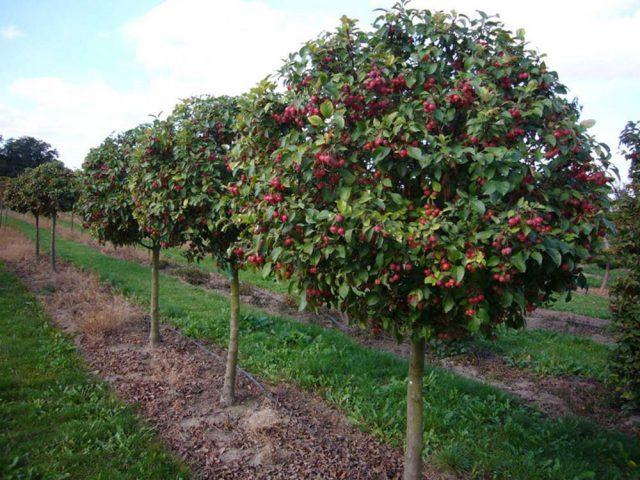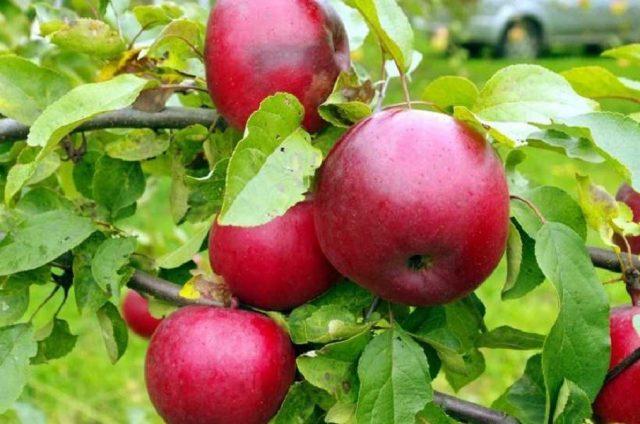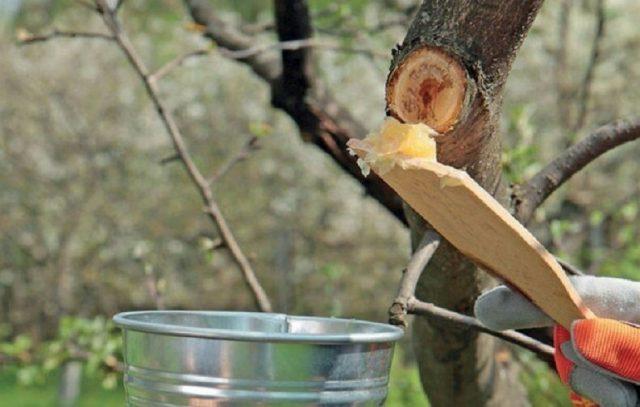Content
Today, standard plants are increasingly attracting the attention of gardeners, because, in addition to their main function (fruiting), they also perform a decorative role. They are still not widespread in Russia, but experienced agronomists note many advantages of the species. An excellent example would be a standard apple tree, which is unpretentious in care and in terms of productivity is in no way inferior to ordinary fruit trees.

Standard apple trees have an attractive appearance, which makes them a decoration for any garden.
What does a standard apple tree mean?
Standard trees are trees whose trunk from the root collar to the beginning of the branches is straight and bare. As a rule, they are not very tall and have a beautiful spherical or pyramidal compact crown. Usually a weeping apple tree is formed on a trunk, as this makes it easier to care for the tree and harvest faster.
Due to their attractive appearance and almost identical shape, standard trees are grown for decorative purposes.They are often cultivated on clonal rootstock.
Advantages
Standard apple trees have a number of advantages that set them apart from other types of fruit trees:
- unusual decorative appearance;
- compact crown that is easily ventilated;
- small growth, which allows you to place several trees nearby;
- good yield indicators;
- practicality and unpretentiousness of plantings.
Among all the advantages, only one disadvantage can be identified - the life expectancy of the tree. Standard apple trees begin to bear fruit earlier after planting, but they also lose this ability faster than regular ones.
The best varieties of standard apple trees with descriptions
Despite the fact that standard apple trees can rarely be found in Russian gardens, there are a sufficient number of varieties. Fruit trees may differ in ripening time, winter hardiness and taste. Also, depending on the variety, the height of the apple tree trunk may vary.
Hope
The Nadezhda variety is represented by a medium-sized tree with a pyramidal crown, which requires constant pruning to maintain its shape. The plant is practically not susceptible to scab infection and is not afraid of low temperatures.
The fruits are quite large in size. The shape is round, slightly flattened. The skin is smooth, green-yellow with a slight blush. The taste is sweet and sour, harmonious.

After harvesting, the fruits of the Nadezhda variety can be stored for up to three months.
Anise purple
Standard apple tree Purple anise is the result of the work of domestic breeder P.A. Dibrova. A feature of the fruit tree is its frost resistance. The plant develops quickly and produces a good harvest almost every year. The crown is broadly pyramidal.
The fruits are small, about 60-80 g.Their skin is smooth and light green. As the fruit ripens, it begins to take on a dark pink hue. The taste is sweet, quite pleasant.

There is a gray waxy coating on the peel of apples of the Purple Anise variety.
Candy
The fruit tree of the Candy variety is a fast-growing one. The crown is powerful and grows easily, so timely pruning is simply necessary for this standard apple tree.
The apples are medium in size. The pulp is juicy and soft. The taste is sweet with vaguely expressed sourness. In terms of ripening time, the variety belongs to the summer variety; after harvesting, the fruits are not stored for a long time.

Candy apples are ideal for canning and preparing winter preparations.
High
The standard apple tree variety fully confirms its name, since the tree is quite tall compared to other representatives of this species. The crown is voluminous, pyramidal. Productivity is good, but not annual, prone to periodicity.
The fruits are small, with a yellow-green peel, which during the period of technical maturity is completely covered with a red blush. After harvesting, fruits can be safely stored for up to 30 days.

The Vysokoye variety belongs to apple trees with a summer ripening period.
Miasskoe
The Miasskoe variety has a rounded crown. The standard tree has good immunity, thanks to which it is not afraid of fungal infections and calmly tolerates low temperatures. Miasskoye is an autumn variety of fruit tree, high-yielding and unpretentious.
The apples are medium in size and standard round in shape. The peel is dense, yellow, from the side exposed to the sun you can see a pale pinkish blush.

The fruits of the Miass variety are medium, weighing up to 100 g
Gornoaltaiskaya
The Gorno-Altai standard apple tree is one of the best among the Siberian varieties. The fruit tree is distinguished by its high frost resistance, stable fruiting and good taste.
The Gorno-Altai apple tree is a fast-growing tree that forms a spreading crown. The fruits are small, weighing on average no more than 40 g. Their shape is round-conical, the color is bright yellow with a solid red blush. The fruit tastes sweet and sour.

The keeping quality of the fruits of the Gornoaltaysky variety is average; fresh they are stored for no more than two weeks
Calville snowy
The Calvil snow variety is an autumn variety. The fruits ripen by September, and they begin to be collected at the beginning of the month. Once removed, they can easily be stored for up to six months.
The Calville snowy apple tree is a fast-growing tree that is not afraid of low temperatures, but in the northern regions the variety is rarely grown.
The fruits are medium-sized, light green in color. The pulp is juicy, dense, slightly sour in taste. As fruits are stored, they turn yellow, become softer and sweeter.

With high humidity there is a risk of powdery mildew infection
Red early
The Red early apple tree is a fast-growing tree. It is early in terms of ripening. The plant has good immunity and resistance to frost. The tree is medium-sized, fast-growing, requiring timely pruning.
The fruits are small and regular in shape. The peel is initially green, then becomes covered with a solid red blush. The taste is sweet, with subtle sourness. They are stored for a long time after collection.

The Red early variety is quite popular among gardeners due to the rapid ripening of fruits and the possibility of their long-term storage
Ruby dooks
The apple tree standard Ruby duki is a winter variety. The plant is frost-resistant, easily tolerating sub-zero temperatures.Productivity is stable and high.
The fruits are large in size, some specimens exceed 150 g. The color of ripe fruits is rich red. The pulp is juicy and dense. Sweet to taste, with a slight sourness.

Ruby duki fruits are harvested in early October; their taste does not change during storage.
Gem
Samotsvet is a standard apple tree variety with a neat spherical crown that requires timely pruning. It is suitable for growing in midland weather conditions.
The fruits are large, reaching up to 300 g. Their color is greenish-yellow with longitudinal red stripes. The pulp is fine-grained, juicy, sweet and sour in taste.

The Samotsvet variety is adapted for cultivation in the northern regions (in the gardens of Bashkiria and Siberia)
Planting standard apple trees
There are no special instructions for planting standard apple trees. They are planted following standard agrotechnical requirements. The process itself consists of the following stages:
- the correct choice of site for the apple tree, which will be well lit and protected from draft winds;
- prepare a planting hole measuring at least 40 by 40 cm, lay drainage material, and also apply fertilizer;
- the seedling is prepared by dipping the roots into a clay mash; you can also slightly trim the tips of the roots to stimulate growth;
- A young apple tree is placed in the hole, the roots are carefully straightened, sprinkled with earth and lightly compacted;
- moisten the soil well and additionally mulch the tree trunk.
Caring for a standard apple tree
After planting a young apple tree seedling, it must be properly cared for. To do this, carry out the following actions:
- water the apple tree twice a week (in rainy weather you can limit it to once);
- after watering, loosen the soil around the trunk and mulch if necessary;
- in the spring they carry out preventive treatment against pests and diseases;
- apply fertilizers at least three times during the growing season;
- perform pruning in spring and autumn;
- prepare the apple tree for winter.
How to prune a standard apple tree
Pruning for a standard apple tree has an important role, as it allows you to correctly form the crown. This procedure is carried out twice a season - in early spring and autumn.
In the spring, as a rule, sanitary cleaning of the fruit tree is performed. Remove damaged, frozen, dried shoots. In autumn, all shoots are trimmed by 1/3. This will promote the formation of young branches.

The cut areas are lubricated with garden varnish to prevent infection.
Conclusion
The standard apple tree is a unique fruit tree that not only produces a stable harvest, but can also become a real decoration of the garden. Most varieties of this species are valued for their compactness, as well as for their tasty fruits.








